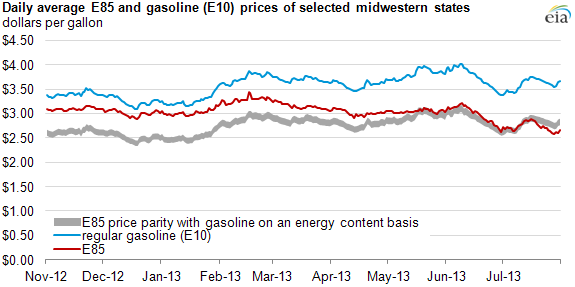
E85 motor fuel is increasingly price-competitive with gasoline in parts of the Midwest

Note: Prices represent daily average observed E85 and regular gasoline prices at the same stations in the states of Iowa, Illinois, Indiana, Kentucky, Michigan, Minnesota, and Ohio. The regular gasoline price shown above represents a subset of all retail outlets selling motor fuels and is not the same as the average regular gasoline price for those states. The width of the E85 price parity with gasoline range reflects variation in the relative energy content of E85 and regular gasoline blends.
The retail price of E85 motor fuel, which is gasoline blended with up to 85% ethanol, has fallen in recent months. While ethanol has been cheaper than regular gasoline on a per-gallon basis for several years, ethanol's lower energy content often meant that consumers paid more per mile when using higher ethanol blends such as E85. However, recent declines in E85 prices at stations offering that fuel in several Midwestern states have brought E85 close to price parity with regular gasoline on an energy content basis.
Price parity on an energy content basis means that drivers with one of the more than 8 million flex fuel vehicles (FFVs) in the country (approximately 3% of vehicles) capable of running on fuels with higher ethanol content can achieve the same mileage per dollar with E85 as with E10 (gasoline with up to 10% blended ethanol), the main blend used in vehicles now.
The lowest E85 pump prices have generally been in the Midwest, where most U.S. ethanol is produced and which, consequently, has relatively low wholesale ethanol prices. Nationwide, approximately 2,350 service stations—or 2% of all retail stations—offer E85 motor fuel, with the overwhelming majority located in the Midwest.
Because E85 is less energy dense than standard E10 gasoline, consumers using E85 will need to refuel more often. In addition, they may need to travel farther to reach a station that offers E85, because they are less widespread. For these reasons, some consumers may not be willing to switch from E10 to E85 until the latter is discounted below its energy parity price. Important questions include how many consumers would not consider switching without such a discount and the size of the discount that may be required.
The pricing of E85 relative to gasoline depends on both ethanol production costs, which are primarily driven by the price of ethanol feedstock (mainly corn), and the price of crude oil, which is the main driver of gasoline prices. Also, under the existing federal Renewable Fuel Standard program, producers and importers of gasoline are obligated to acquire renewable fuel credits, known as Renewable Identification Numbers (RINs), which are generated during the production of renewable fuel. Since February, the rise in the market price of ethanol RINs has tended to reduce the price of E85 relative to E10 because production of E85 generates more RINs than production of the standard E10 blend. As the extra RIN value to E85 producers is passed along through the distribution chain in the form of a price discount, E85 becomes more competitive with regular gasoline.
Customers accustomed to comparing gasoline prices on a price-per-gallon basis may not be familiar with how to compare fuel prices on an energy basis. E85, which can have up to 25% less energy per gallon than regular E10 gasoline depending on seasonal variation in fuel specifications, needs to be discounted a comparable amount for consumers to achieve the same mileage per dollar (see chart below).

Note: Prices represent daily average observed E85 and regular gasoline prices at the same stations in the states of Iowa, Illinois, Indiana, Kentucky, Michigan, Minnesota, and Ohio. The regular gasoline price shown above represents a subset of all retail outlets selling motor fuels and is not the same as the average regular gasoline price for those states. The width of the E85 price parity with gasoline range reflects variation in the relative energy content of E85 and regular gasoline blends.
While fueling with E85 may now be a price competitive option for some consumers with FFVs, other ethanol blends, such as E15, continue to face challenges unrelated to pricing. Although the Environmental Protection Agency authorized E15 to be used in vehicles manufactured in 2001 and later, most U.S. vehicle warranties do not cover the use of E15. And, because of potential liability issues arising from use of E15 in vehicles and small engines that are not approved for its use, only a handful of retailers currently offer that blend.
Principal contributor: EIA staff